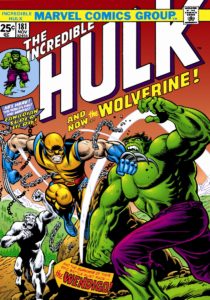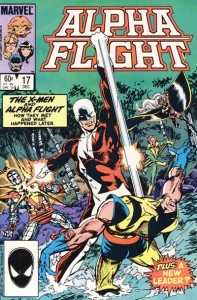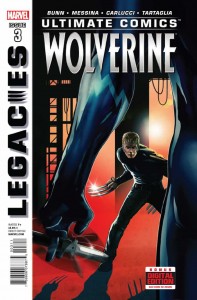Wolverine first appeared near the end of 1974. Children who read that comic would be past middle age before his background would be fully sketched in (assuming the job’s done). It is easy to forget, now, but originally the Wolverine was a mystery man, even to himself. Neither he nor we knew who he was.
Do not forget, all we knew at the start was Wolverine was associated with the Canadian Government, he had some kind of Chinese climbing claws fixed into his gloves, he had animal-like heightened senses, when wounded he healed quickly, he had a really bad temper, he had fangs, he was among the last people anybody with a brain would tell, “bite me.”
By the way, he was fighting the Hulk. Which told you what league he was in.
Over the following years, information about the Wolverine would drip out. It was revealed he was a mutant so he became part of the X-Men roster. Bare chested and in jeans, Wolverine fought with his claws. Banshee, who wouldn’t last that much longer as a member, says, “…your claws, they’re a part of yea, I…we…didn’t know.” Wolverine answers, “Why should you, Irish, it’s none o’ your business.”
Wolverine was nearly dropped. He didn’t fit in with the other heroes, and every once in a while somebody upstairs decides they have the formula just right and no one’s allowed to try anything new. Wolverine has two distinctions from heroes who preceded him. First, he is seized by an anti-social hatred that he had to control. He is sometimes called an anti-hero for this trait, but that’s not correct. He is actually a flawed hero. Second, he is Canadian. Superman came to Earth and became American, which he asserts as late as Man of Steel. Wolverine is Canadian, as he asserts in Origins: Wolverine.
John Byrne didn’t want to drop the Canadian hero, being Canadian, himself. So it was lucky that Dave Cockrum, who preferred Nightcrawler, left and Byrne came in. Instead of dropping Wolverine, he created Alpha Flight, the first big addition to Wolverine’s backstory.
Instead of being dropped, instead of staying a peripheral character, Wolverine eventually grew into a money-making machine. It took years, but when Marvel decided it needed an Earth-2 of its own, Wolverine had developed into what they needed.
Instead of being the guy who didn’t fit the mold, he became the guy who was the mold. Comics are like Hollywood and wrestling and lots of other businesses: if it works, do it again. DC made extra Supermen and Batmen, Hollywood has sequels by the squillion, and wrestling history is littered with Cowboy this and Chief that. Wolverine was working, Marvel’s job was to exploit him.
By Marvel’s Earth-2, I mean the Marvel Ultimate imprint. It started with Spider-Man and expanded to the X-Men, the Avengers (called the Ultimates), The Fantastic Four, and generally all the better-selling Marvel products. These were more than extensions of the line, they were re-imaginings, with increasingly different origins, and increasingly different lives to go with them. Eventually Spider-Man would be flashed, since his costume would change and under the mask he would not be Peter Parker but Miles Morales. Wolverine was part of this mix.
Instead of being a superhero, the Ultimate Wolverine was over time moved more into the status of a super powered agent running a black ops team. Instead of volunteering to have his bones laced with adamantium, he was kidnapped and experimented on. But he still has heightened senses, strength, claws, a bad temper, and a tendency to go berserk that he has to keep under control, and fangs. In other words, still not a person to tell, “Bite me.”
But Marvel Ultimate series are marked by something Marvel’s mainstream series rarely sees: death. Ultimate Marvel had a lot of death, because the death of the second version of a character did not stop the cash flow. Eventually, Marvel would revive the Ultimate series with a third version of its better-selling characters. In the meantime one of those deaths was Wolverine.
An Ultimate Wolverine had several advantages for Marvel (and still does). Suppressed subplots can be brought to the fore, alternative ideas can be explored. This second Wolverine let Marvel explore the attraction Wolverine felt toward Jean Grey when he first joined the X-Men. This second Wolverine joins the X-Men not as a member of the new team sent to save the old, like in the comics; this Wolverine is not a refugee from Magneto, like in the movie, X-Men. He is an infiltrator, sent by Magneto.
Over time, Wolverine’s attitude changes. He recants his affiliation to Magneto and joins the X-Men for real. Eventually, he goes on to run black-ops missions with his own team. In this we get to see Wolverine continue along a path he didn’t take mainstream, the option of returning to the black ops path. It gets him killed.
Magneto does it. Nice close-off of a plot arc, but it opens up new possibilities. Because it allows the writers to explore the whole theme again.
Wolverine begins as a man who can not remember his own past. He is as much a mystery to himself as he is to his readers. Various arcs of plot revolve around Wolverine discovering something else about himself. Marvel Ultimate could do the same thing after his life with his son.
Wolverine: Legacies is available now and it follows the story of Jimmy Hudson, the son of the Wolverine. The book is written by Cullen Bunn with David Messina on pencils, Gary Erskine and Gaetano Carlucci on inks, and Javier Tartaglia as colorist. It unfolds in alternate chapters of flashback and present day. As the plot progresses, clues about what it all means are developed. We start out knowing there was a plan which Wolverine stopped, but the job wasn’t finished and danger has resurfaced.
Raised by human parents, Jimmy now lives on a reserve for Mutants. The trope of the Mutant Registration Act and general ‘it just might happen here so be afraid’ plot is background to this. It’s a reservation.
Jimmy has a recording of his father which he plays again and again as if on the thousandth playing it will be different, it will contain new information, it will answer questions that have plagued him for years. And that’s what happens.
Jimmy Hudson is viewing the holographic recording of his father one more time when his friend on the reservation, Black Box, hears something no one else can. Black Box is a technopath, which means he can talk to technological objects like computers and they can talk to him. He gets the information hidden in the recording. With that Jimmy and Black Box leave the reservation, which of course they are not meant to do.
So from the second beginning we have a chalk and cheese team. Jimmy will do the hard man stuff, while the technopath Black Box will open every door, every data file, unlock every password. He will also run from guys who want to start a fight. Jimmy fights.
Another one of those guys not to tell, “Bite me.” But you don’t have to take it so seriously because Jimmy is not the best at what he does. He’s not as good as father.
At this early point, we’ve only been told that his father had a mission that killed him, and that he left something undone. We don’t know what, but his son has a personal mission to discover it. He believes the answers to those questions will help him sort himself out.
This is the core of Wolverine’s initial appeal. He doesn’t know who he was and rather than build his life with where he is and what he is doing, he looks for his memories. He thinks his past will tell him who and what he is. This is the opposite of the message being offered in the media in the seventies. Then the idea was you could remake yourself again and again, you could shed your past as soon as it was inconvenient to you. Identity was not created from events, it was invented from the top down.
Wolverine, and Jimmy after him, take the opposite extreme and make it the center of their story. It is not a repetition that would be possible if Wolverine had lived. He would simply give Jimmy the answers he so desperately needs. And together they would have done better in fights. So by killing Wolverine, Marvel can sell that sort of story again: look back to see where you’re going.
Remember, it is not mainstream Wolverine’s story. The accumulation of backstory continues with him. This is Ultimate Wolverine, Wolverine Earth-2 as it were. So Jimmy Hudson is the third iteration of selling the story of Wolverine. Think about that, it’s as if DC were selling comics of both the Earth-1 and Earth-2 Superman at the same time, then they killed Superman of Earth-2 and started publishing stories about the son of the Earth-2 Superman. You’ve got to admit, that’s one heck of a sales plan.
In Hollywood terms, Marvel sold Shrek, Shrek 2, and with this story is selling Shrek the Third. Is it worth the while? This time, yes. The story is engaging and you actually give a damn what happens to the characters at the end of the story, particularly Jimmy.
One positive in this comic is the kind of brutalist style used. Inks are usually heavy, lightening considerably when Jimmy looks at his foster parents from a distance. The colors are dark with inks providing heavy shadow. This darkened albedo for every hue applies not only at night (and a lot of this story occurs at night) but during the day and indoors under artificial light.
There are some differences between Wolverine and Jimmy Hudson, and it’s the Hudsons. Jimmy has human adoptive parents who love him. Several times he makes the point that Wolverine was his father but James Hudson raised him. In a world where mutants are automatically taken from their parents, where Wolverine was part of that process, he was taken to parents of the oppressor. It is touches like that which make the story an exploration rather than an exposition.
And what an exploration. Tragedy is layered on tragedy, in Wolverine’s life and the life of his son. What we watch is Jimmy Hudson, son of the Wolverine and of human parents, fighting to find himself as he stands between worlds, between paths of life, between an unknown past and an unknowable future. And in all this he’s just a kid and he’s outmatched by his opponents.
If he were as good as his father he’d be a bully. Instead, he takes on forces greater than himself, including a brother he didn’t know he had. This is Ultimate Wolverine, remember, and a spoiler’s about to pop up. This Wolverine fathered not only Jimmy, but Quicksilver.
This Quicksilver is more like the version in the cartoon, Wolverine and the X-Men. But he’s also more like his father. He’s still superfast, but he also kills people a lot. Like Wolverine, he has that dark side. But Quicksilver doesn’t suppress it. He seems to think giving in to it makes him superior. And this Quicksilver is a smug little bastard who likes using knives to skin people dead.
In this, Quicksilver has been melded with Sabretooth.
You know the crux of the story has to be big brother versus little brother at least at some stage. And Quicksilver is determined that Jimmy and Black Box will provide him with what he needs because, well, it’s all about Quicksilver.
Both brothers are looking for salvation and a sense of identity. They take opposite views on how to do this and, naturally, have opposite instincts. Quicksilver is looking for the big theory, the ideological permission to do what he wants to do in any event. Jimmy isn’t looking for an ideology or some grand arc of the solution to everything. He’s interested in finding out and reaching out.
So when Quicksilver kills someone just to show the stakes on the table in this whole thing, Jimmy goes berserk. Just like his dad, except not.
Quicksilver is ahead of Jimmy, knows more about that final mission. But Quicksilver wants to use what Wolverine fought against. It’s his usual goal, some sudden power to change the balance of power between homo sapiens and homo superior. All he has to do is demand Jimmy help him, imprison Jimmy, torture Jimmy until Jimmy realizes the death of innocent people is just the price you pay for a greater good.
And that isn’t how Jimmy sees things. Nothing will make either Jimmy or Quicksilver change their position, any more than Wolverine or Sabretooth would shift their views. In both cases the conflict is to the death.
Or from the death. As they battle the past ceases to be inspiration for the present and becomes a leavening in it. Not everyone died back then. And that intervention changes the course of events.
The solution to the story is not simple, nor is it one-sided, but it is satisfying. Life is not tied up neatly, but it does come to points where things turn. Legacies brings us to such a point when the past is brought into the future. We live or die, we take one path or another, and that path will identify us.
Marvel has sold that story three times, and each time sold it very well. It remains to be seen if it will use Ultimates to develop a new way to sell a story. Open the story with the superhero in the eternal second act of being the hero. Then, in Ultimates, tell the whole story, from beginning to finish, and tell it again and again.
Then the most successful parts of the complete story can be leavened back into the original eternal second act, which never stopped being told. It is a brilliant way to take what selling, sell it again, and again, and use those later sales to improve the first sale.
This is a comic book, where bullet points use real bullets and clawing your way to the top is not a metaphor. But by the end, don’t tell Jimmy, “Bite me.” Seriously. It’s worth the read more than once.




Comments are closed.